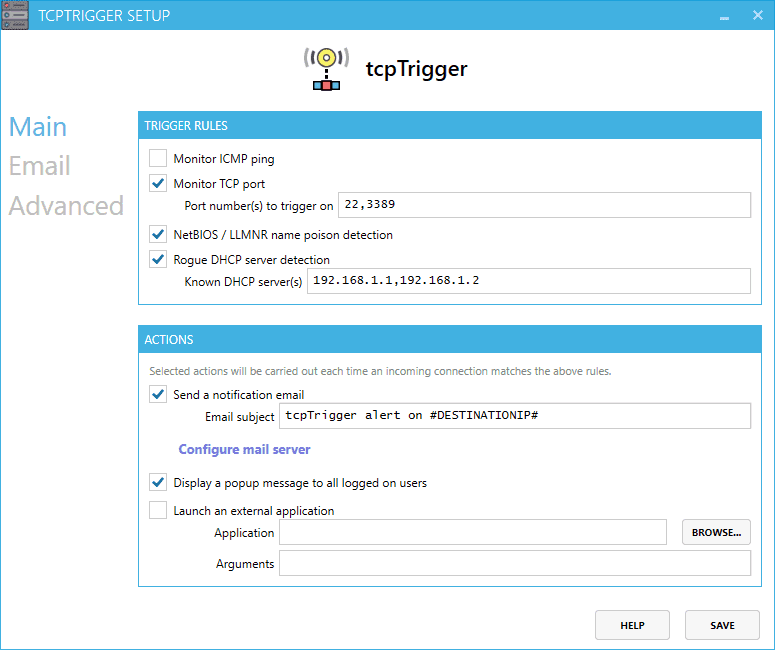tcpTrigger: A windows service that notifies you of incoming network connections

tcpTrigger
tcpTrigger is a Windows service intended to notify you of incoming network connections. You specify a TCP port to monitor and an action to take. Actions taken include: sending a notification email and/or launching an external application or script. Your action will then be triggered each time an incoming connection is attempted on your specified port.
Features
Intrusion Detection
For a simple, yet effective, internal intrusion detection system, deploy tcpTrigger. Attackers who are unfamiliar with your network must first map out live hosts and running services. This is typically accomplished with a port scanner, such as Nmap. An intruder cannot steal sensitive documents without first discovering your file servers, and they cannot dump your user mailboxes without first discovering your email servers. If your tcpTrigger system gets probed, you will be alerted to the intrusion. Your tcpTrigger system can alert on incoming ICMP echo requests or on connections to any TCP port. You can monitor ports with existing services or even ports with nothing listening. Detection works the same whether the port is open or closed. It will even detect ‘half-open’ connections used by most port scanners. For an IDS deployment in an enterprise environment, install tcpTrigger on a dedicated system and configure it to monitor incoming ping requests and common TCP ports such as 80 and 23. tcpTrigger automatically listens on all available IPv4 network interfaces, so you can easily monitor multiple subnets from a single installation.
NetBIOS and LLMNR Name Poison Detection
As far as I know, tcpTrigger is currently the only solution capable of detecting NetBIOS and LLMNR name poisoning. The way it works is very simple: every few minutes it broadcasts NetBIOS and LLMNR name queries for fictitious names, and if a response is returned, an alert is triggered.
Name resolution poisoning is a highly effective attack that is carried out on a local network. Check here for an overview. There are two broadcast-based name resolution technologies enabled by default in Windows: LLMNR and NetBIOS over TCP/IP. A Windows workstation will typically resolve names using DNS, but LLMNR and NBNS will be used in certain cases where DNS resolution fails. The problem with broadcast-based name resolution is that anyone on the same subnet can provide a malicious response to queries. Not only that, Windows will often willingly provide your username and NTLMv2 password hash to whatever system it ends up communicating with. And to make it worse, Google Chrome performs three random name queries when the application is launched. That random name queries very likely won’t be resolved by DNS and will then be broadcast using LLMNR and NBNS. So by simply opening Chrome, you might be sending your password hash to a malicious person on the network. There are several tools which make this attack very easy to carry out: Responder is an example. You should always disable LLMNR and NetBIOS over TCP/IP if they are not needed. The great part about the name poison detection built-in to tcpTrigger is that it will work even if you have NetBIOS disabled.
Rogue DHCP Server Detection
This feature alerts you when an unknown DHCP server is seen on the network. It is limited to the local network segments that are being monitored by tcpTrigger. In the configuration, list the IP addresses of all expected DHCP servers. tcpTrigger will then alert you as soon as any other DHCP servers are observed on the network. You can also choose to not specify any DHCP servers in the configuration. In this setup, tcpTrigger will alert you when more than one DHCP server is detected (and each DHCP server discovered thereafter).
Connection Notifier
Not interested in intrusion detection and you just want to know when someone is connecting to your important services? Use tcpTrigger to monitor the ports you’re interested in and you’re set. Each time someone connects, you can have tcpTrigger display a popup message, send an email notification, or you can even kick off a script.
Download
git clone https://github.com/R-Smith/tcpTrigger.git
Usage
Name poison detection example (popup alert)
Rogue DHCP server detection example (email alert)
Port scan detection example (email alert)
Ping detection example (popup alert)
Copyright (c) 2016 Ryan Smith
Source: https://github.com/R-Smith/









